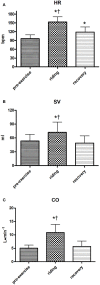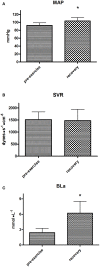Hemodynamic Responses during Enduro-Motorcycling Performance
- PMID: 29311986
- PMCID: PMC5736362
- DOI: 10.3389/fphys.2017.01062
Hemodynamic Responses during Enduro-Motorcycling Performance
Abstract
Much of the information available in the literature on physiological responses during Enduro motorcycling is related to heart rate (HR) and blood lactate (BLa). The aim of this work was to investigate the hemodynamic changes that occur during a 10-min session of Enduro motorcycling. Fifteen skilled riders were enrolled on the study and all participants underwent an Enduro-motorcycling session on a standard track. Hemodynamics were assessed using a miniaturized impedance cardiograph. Results show that HR significantly increased from 96.5 ± 12.8 bpm at rest to 153.1 ± 17.7 bpm during riding, while stroke volume (SV) increased from 53.5 ± 14.1 to 72.2 ± 22.1 ml and cardiac output (CO) from 5.0 ± 1.1 to 10.9 ± 3.0 L·min-1. Moreover, ventricular emptying rate (VER) increased from 192.9 ± 43.0 to 324.1 ± 83.6 ml·s1 and ventricular filling rate (VFR) from 141.1 ± 160.5 to 849 ± 309 ml·s-1. Taken together, these data suggest that Enduro motorcycling induces substantial cardiovascular activation, not only in terms of chronotropism but also in terms of cardiac performance and pre-load, thereby increasing SV and CO. Finally, it is likely that sympathetic-mediated venous constriction occurred. This in turn improved VFR and recruited the Frank-Starling mechanism and inotropic reserve. It was concluded that Enduro motorcycling is a challenging activity for the cardiovascular apparatus.
Keywords: blood lactate; blood pressure; exercise pressor reflex; heart rate; stroke volume.
Figures





References
-
- Carter R., III., Watenpaugh D. E., Wasmund W. L., Wasmund S. L., Smith M. L. (1999). Muscle pump and central command during recovery from exercise in humans. J. Appl. Physiol. 87, 1463–1469. - PubMed
-
- Charloux A., Lonsdorfer-Wolf E., Richard R., Lampert E., Oswald Mammosser M., Mettauer B., et al. . (2000). A new impedance cardiograph device for the non-invasive evaluation of cardiac output at rest and during exercise: comparison with the “direct” fick method. Eur. J. Appl. Physiol. 82, 313–320. 10.1007/s004210000226 - DOI - PubMed
LinkOut - more resources
Full Text Sources
Other Literature Sources
Miscellaneous

